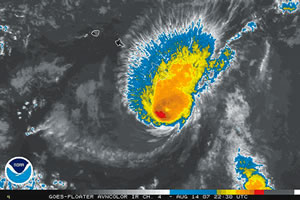A few facts about fearsome Flossie

Friday - August 17, 2007
| Share
 Del.icio.us
Del.icio.us
|
Aloha, surfers and beachgoers! That was a close call with Hurricane Thong ... I mean Flossie. With all due respect, she was a whomper of a storm - at one point bigger than the length of the entire Hawaiian Island chain. Flossie brought rare 20-foot wave faces to the Big Island’s ESE sector and 50 mph winds ... not to mention the gobs of rain and thunderstorms.The eye just missed us to the south, but it really looked like a direct hit was possible. Thank God we were safe from such a fate ... this time.Flossie brought extreme caution and some fear as well - a reminder of our relatively insignificant size.
The media coverage was excellent, and the National Weather Service forecasters superb.How they can predict so accurately is amazing. They have forces of nature pinned down to probabilities. They do their best to crunch and connect numbers to nature - a nearly impossible task if you ask me, but they do and it can work, as it did with Flossie.
Now I know many of you were secretly wondering about this particular name. It’s not like Frank or Fred at all,if you know what I mean. I know I had and heard more than a few conversations about Flossie ...Is he a she or she a he? Who named it? Why do they name these storms? What’s in a name?
Well first, it’s a girl - has to be - ‘cause if my name were Flossie it’d be worse than a boy named Sue, but at least I’d be tough. Second, I can tell you there’s a gazillion names in place already through 2012 - from A to Z for just about every ocean. The first storm of the season starts with A,the second B,third C ... all the way through the alphabet.
Lastly, I found out why a storm’s name is pretty simple: to make communications quicker and clearer. Experience shows that the use of short, distinctive given names in written as well as spoken communications is faster and less subject to error than the older more cumbersome “latitude-longitude"identification methods.These advantages are especially important in exchanging detailed storm information among hundreds of widely scattered stations, coastal bases and ships at sea.
I agree 100 percent. Can you imagine if in every newscast you heard:“Major Hurricane: 16.9N and 154.1W heading in a northwestern direction at 15 knots packing 140-155 knot sustained winds”? We’d all be blown away before it even got here, so to speak.
Now going back to the male/female debate - it’s real. In fact, the boys had to compete to get their names in the exlusive lineup of storm names. Since 1953, the original name lists featured only women’s names. In 1979, men’s names were introduced and they alternate with women’s names. Tropical storms have been named from lists created by the National Hurricane Center. They are now maintained and updated by an international committee of the World Meteorological Organization.
I’d bet my life that those early days were a bunch of guys ... whatcha think?
Human events coming up: The Duke’s Oceanfest, Aug. 18-26 Waikiki Beach.
The HASA Surf event No. 2 at Tennis Courts, Sept. 1 and 2.
I’ll be posting results and more info at SURFNEWSNETWORK.COM, of course!
See you out there in the lineup and back here next week in MidWeek!
I’m GQ, dropping in 4 U!
E-mail this story | Print this page | Comments (0) | Archive | RSS Comments (0) |
Most Recent Comment(s):













